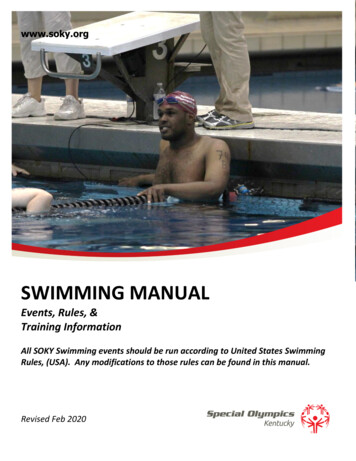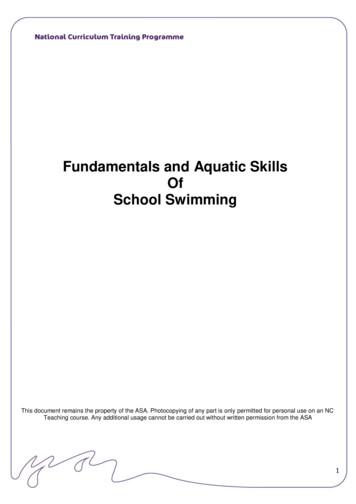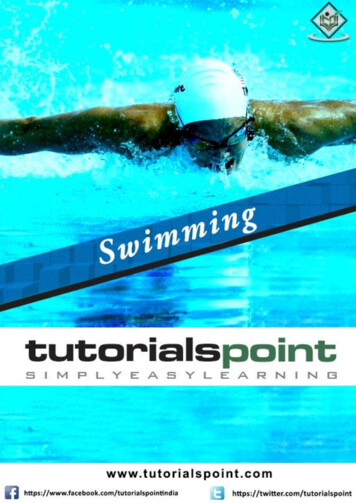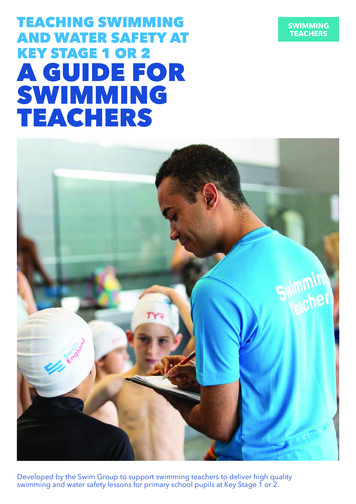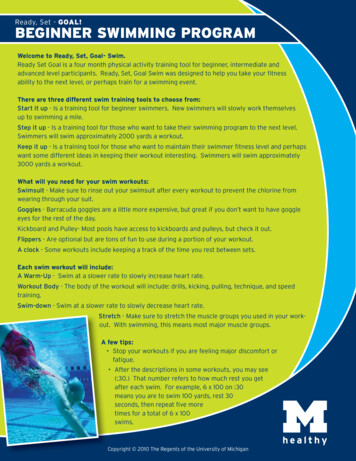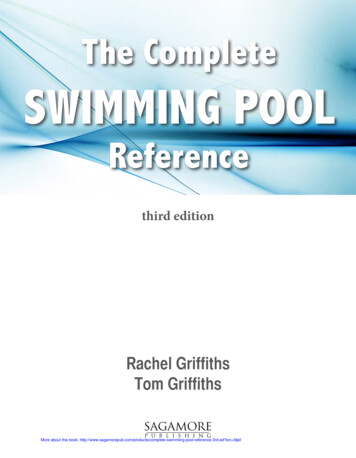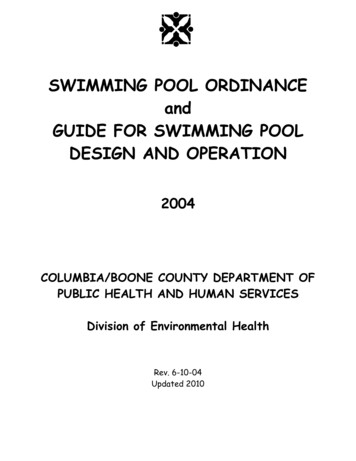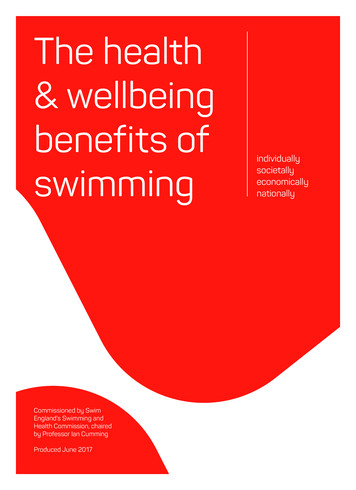
Transcription
SWIMMING FOR ALL – SWIMMING FOR LIFE MANUAL
SWIMMING FOR ALL - SWIMMING FOR LIFELearn how to swim, the basics.It is my great pleasure to introduce you this “Swimming for All,Swimming for Life – Learn how to swim, the basics” Manual, as part ofFINA’s global effort in the development of Aquatics in the fivecontinents.In general, our International Federation is perhaps more known for thememorable events it organises and for the great Stars of our sixdisciplines. FINA is a pillar of the Olympic Movement and wasincluded, after the 2012 Games in London in the Group A of theInternational Olympic Committee regarding the importance it bringsto the Olympic programme.But as a world governing body, we think that we also have a socialresponsibility towards the children and youth of the world. Especiallyto the ones still not acquainted with our magnificent and naturalelement, water.According to very alarming statistics, more than 370,000 lives are lostevery year due to drowning on a global scale. As the guardians of theAquatic Sports, FINA could not face this reality without acting!That is why, we have launched this programme – “Swimming for All,Swimming for Life”. This initiative’s main objective is to offer thepossibility to individuals from all ages, different backgrounds andcapabilities, to take swimming lessons.The “Swimming for All, Swimming for Life” programme will providestandard criteria to teach swimming on a global scale – this is thespecific goal of this Manual - and will be mostly carried out in thosecountries on the five continents where the need is most urgent.By doing so, swimming will be more accessible, democratising itspractice.The programme’s application requires planning, implementation,follow-up, evaluation and sustainability. Therefore, it is vital to counton the government’s’ implication by offering the required logistical andfinancial support in each country where it will be implemented.As the FINA privileged partners in the five continents, our 208National Member Federations have a special role in this strategy. All ofthem are naturally aware of the importance of Swimming, but theymust now convince their local authorities of the crucial importance ofthis programme.Alone, FINA cannot act. We are offering the tools, but we needfavourable conditions to develop this project.I count on all of you to achieve it!If we are successful, we can save many lives, we can provide a betterfuture for our children, giving them not only the possibility to practicesport, but also educating them to be better citizens.In their name, and on FINA’s behalf, THANK YOU!Dr. Julio C. MaglioneFINA President
PROCESSOF ADAPTATIONBASIC PROCESSFor a person to be safe in the water, ideally they need to passthrough the following two stages:Learning to swim is more difficult and more complicated when aperson is affected by fear. This stage of adaptation is designed1. Getting used to the water (adaptation)specifically to establish, through a combination of support, teaching2. Learning swimming techniquesand methodology, a step-by-step approach for the student, to bringthem gradually to a level at which they positively embrace anunfamiliar medium, water. This approach should be basic, allowingthe student to enjoy being in the water, with the security providedby the teacher and swimming aids, and with a gradual escalation ofactivities in terms of difficulty.www.fina.org03
a. Activities which involve putting one’s foot in a pool/at thebeach/lake, etc.Goal: to familiarize oneself with the water, overcome anyinitial fears, begin the process of postural retraining. Depthof 50-90 cm.1. Students simply walk in all directions, getting round obstaclessuch as poles, with ropes above.2. Incorporate little methodological games focusing on movement,carrying simple items, etc., where the game and the interesttaken in the items distracts the student’s attention away fromthe fact that they are in a "dangerous medium".3. If the pool or water is very shallow, get the student to supporthimself with his hands, suspend his body while supportinghimself with his hands, kick his legs as if swimming the crawl.4. Games with balls, throwing and moving about, etc.www.fina.org04
WHAT IS POSTURAL RETRAINING?We all (as bipedal creatures) base our stability parameters, bothstatic and dynamic, on spatial physical references. We have an infront, a behind, two sides, an above and a below. With thesecoordinates we move in the world.Our brain registers these conditioning data for most motor actionswe perform in our daily lives. However, these data are useless whenthe body changes position and lies in the water. What was above isnow behind, what was below is now in front, and so on, always withreference the original framework of bipedalism.Naturally, when the body changes position and lies in the water,this, together with the lack of a solid support, causes all the datagained from the experience of life to be blocked, leading to tensionin the body, doubts and awkwardness in movements, andsometimes fear or despair.We therefore need to create a new database, which will assist thebrain in progressively interpreting the new position the persontakes in water. You only have to watch the difficulty experienced bya person when he lies the water for the first time, and theresistance he puts up both voluntarily and involuntarily to doing so,automatically raising his head and losing his sense of horizontality.The same happens when a person dives into water, and raises hishead to face forwards, resulting in a horizontal position as he fallsand a sharp slap: the classic “belly flop". What makes him do this?Quite simply, he is seeking his historical horizon - his “in front” thereby generating undesirable positions for natural floatation.It is therefore essential to gradually get used to the new position,what we call postural retraining.www.fina.org05
EXERCISESLie supported by the teacher.Lie on an airbed or other item.Take up a horizontal position,supporting the hands on the floor.Another issue to consider for special cases is putting the head in the water. It is suggested that you do not verballyurge or induce the student to do this, just let personal experience take its course, and thus the student will create hisown framework of learning, security and self-esteem. In most cases, this problem will not occur, but "special cases" willalways arise at some time in the various groups.www.fina.org06
b) Deep poolIt may be that you are in a pool in which students cannot reach thefloor with their feet.In this case keep groups small:1. Appoint a safety observer at the edge of the pool.2. Safety is paramount in this area. A case of fright can affectothers and set back the learning process.3. Use aids to assist floatation and movement. Recommend thatstudents wear float jackets which incorporate pieces ofpolystyrene foam or plastic measuring around 20 cm. Try not touse inflatable arm bands or underarm floats, as these tend tocondition and inhibit natural arm movements.In this way, students can float and move their legs and armswhile feeling reassured by the float.Many teachers prefer to dispense with these aids, but when thegroup is very large, it is advisable to rule out any possible risk.4. If possible, construct platforms that raise the floor and children– in this case – can reach the floor with their feet. Clearlydelimit the area where the class is taking place.5. Your position vis-à-vis the group is: always in the pool, alwaysfacing the group; "never turn your back, and never lose sight ofthem". While working, observe the group.You will thus have the issue of safety under control.www.fina.org07
www.fina.org
TYPICAL EXERCISEVENTRAL FLOATATIONDORSAL FLOATATIONVentral floatation, with or withoutWe shall refer to the basic act as ventral floatation.1. Exercise lying on a floating mat, just so that themovement, is the ultimate goal of theThis is an action that many believe to be simple, asstudent can experience the position on aprocess that begins with adaptation.long as "postural retraining" has been successfullymoderately solid surface. It is advisable to useaccomplished. If not, it will require a little more work.mats of different thickness if available, startingRemember, adaptation is the processIt is not easy to move the arms while kicking the legsfrom the thickest to the thinnest/least sturdy.of familiarization of a person who,at the same time, but this is a classic “doggy paddle”because he is unfamiliar with water,action that comes naturally in the first few years offears it, is intimidated by it, and thislife, so that the next step should not feel totallyprevents him from trying to tacklestrange, especially for children. You may start withmore complex tasks.floats and then, as the student progresses, graduallylimit the use of these aids. As progress is achieved,Once this stage of adaptation has beenyou may move on to the second floatation position,completed successfully, and the personwith or without movement by kicking.is comfortable in the water, with someconfidence, the process continues withprogressively more difficultmethodology, always from the simpleto the complex, and at this point itbecomes possible to introduce the actof floatation, both ventral and dorsal.2. The presence of the teacher in the water,accompanying the student through the exerciseby supporting him with hands on his back and/orhead, is essential for the student to feel safe andsecure, since it is not easy for a beginner to lie onhis back.www.fina.org0903
SUMMARYWe have gone over a very important aspect of theprocess of developing student safety. The process ofgetting used to the water is essential for most people,regardless of age. You may find that, as this is a highlyindividual process, the number of classes requiredwill vary. We have described the process in verygeneral terms to facilitate comprehension andprovide uniform criteria.www.fina.org10
THE BASICSUndoubtedly, with regard to the various possible waterA TEACHER WITH A SOLIDFOUNDATIONenvironments where the learning process may take place,consideration must be given to a number of factors that make thisWhat knowledge do we need to be a good teacher? A set of basic principles will form the best foundation for aprocess completely reliable. These are:teacher to help students to overcome obstacles, teach them the right movements, and ensure the success of aperson who has the potential to master the water with the right techniques.1. Possibilities offered by the infrastructure.2. Teaching staff.1. Technical / mechanical principles.2. Methodological principles.With regard to the teacher, it is imperative that the teacher have3. Physiological principles.special training in the subject he teaches.4. Teaching principles.5. Regulatory principles.We will go into just two of the above in more depth.www.fina.org11
TEACHING PRINCIPLES1. Tailor the process for individual learners within groups.2. Interpret the needs of each student.3. Establish strategies for progress in each class, in accordance with the weekly lesson plan.4. Ensure a gradual increase in difficulty in the exercises, from simple to complex.5. Set the safety parameters in the class.6. Plan and evaluate each class.PHYSICAL/MECHANICAL PRINCIPLESThe teacher must know that:1. The water offers resistance to the swimmer as he advances (principle of resistance).2. Both the arms and the legs can perform propulsive actions (principle of propulsion – law of action andreaction, law of lift or pressure differentials).3. In styles involving alternating arm movements, the body rocks from side to side (principle of rotation).4. The body floats, both owing to the characteristics of the body itself, to a greater or lesser extent, andthrough the use of lifting manoeuvres (principle of floatation).5. The arms perform two fundamental actions in their movements (principles of traction and recovery,associated with coordination).6. The subject must adjust his breathing to the sequence of arm movements (principle of breathing).7. The student must move his hands and arms through different areas under the water in terms of bothdepth, length of stroke and lateralness/tridimensioness of the stroke (principle of seeking different areasof thrust).A teacher with a knowledge of all these principles will be a great swimming teacher, as these aspects will becovered. The foundations are laid for a successful process.www.fina.org12
SUMMARY OFEXERCISES FORTHE PERIOD OFADAPTATIONTotal days: approximately ten to twelve 45-minute classes.Total number of students per teacher: shallow pool, 6-8students; deep pool or natural environment, 2-3 students.It is recommended that there always be an assistant forsafety reasons.The exercises proposed herein are just a summary of the broadvolume of literature consulted in a variety of countries, the aimbeing to point out the steps to be followed in the process ofadaptation and learning, and no doubt many different versions canbe added to what is recommended as guide here.Note that the specialist literature identifies and recommends over2000 simple and complex exercises. This period is very important,especially for people who do not have any experience of the water.The time required for this process will very much depend on theindividual. Some people need just a few classes before they can goon to join another programme, others will need more attention andmore exercises before they can get into and stay in the waterwithout restrictions.It must also be borne in mind that the activities described here areaimed at students aged 5 and over. For younger children, theactivities must be specially tailored to their age.www.fina.org13
DAYS 1 – 2 – 31. Exercises to familiarize students with the space where they willinteract with the water, as regards depth, the possibility of anuneven/sloping floor, the type of floor, viscosity or turbidity ofthe water, etc. Simply walking in all directions, then jogging (allin the same class).2. Games or activities involving moving about in the verticalposition, moving around obstacles such as rings, ropes, poles.3. Games and activities with balls, moving the ball from one edgeto another, introducing some difficulties or variants in therepetitions, alternately pushing with one arm then the other,with the chest, etc.www.fina.org14
DAYS 4 – 5 – 64. Simple exercises involving immersing the face in the water.There are about 100 different exercises, some in the form ofgames.5. Postural retraining exercises. Lying on a floating mat – assistedand supported by the teacher, who holds the student’s hands –supported on an edge of the pool – supported and assisted bythe teacher with a pole – supported on the bottom of the pool ifit is shallow (all these exercises in the ventral position) – two orthree children lying on a floating mat and being moved aroundthe pool by the teacher.6. If the pool is deep, get students to move across the waterholding on to the edge. If working in a natural medium that isnot a pool, secure a tensioned rope where students can grasp itand perform exercises to move about (never do this in areas toodeep to stand). For all activities carried out water which is deepfor the students, they must wear a life jacket while doing theactivity.7. Exercises holding on to a kickboard, students kick their legswhile the teacher helps them to cross. Do these exercises withthe head out of the water, and also with the head in the water ifthe student is ready for this.8. Standing still, inhale water through the mouth with the head outof the water and then exhale through the mouth and nose whileducking the head under the water. Repeat the exercise whilewalking about the pool.9. There must always be an assistant observing from outside thewater to ensure the safety of the group.www.fina.org15
DAYS 7 – 8Start activities for ventral floatation: walking around with the waterup to the chest, and arm movements for support and propellingbackward.10. Same exercise, holding on to the kickboard, changing thegripping hand, in order to get used to alternating arm actions.11. Exercises kicking the legs while alternating arms.12. Exercises in the ventral position, while the teacher providessupport with his hand under the chest, the student tries to kickhis legs and move his arms while floating and moving acrossthe water.13. Basic locomotion exercise on own with jacket, butaccompanied by the teacher.Note: Whenever you are working with a child, you mustalways be in front of or beside him, never behind. This willgive the child more confidence in you. If are behind thestudent, he will sometimes try to look at you, arching thebody and causing considerable muscle strain to his neckand body.www.fina.org16
DAYS 9 – 1014. Exercises for adaptation to the back position, on floating mat,with the head on the teacher’s hand (the teacher’s other handis on the student’s back), first do while stationary, then movingacross the water (without jacket).15. Exercises in ventral position, changing to dorsal position, withor without leg and arm movements by students. Alwaysassisted by the teacher.16. Exercises in dorsal position, moving about, student unassisted.Important: Always remember that a student will not makeprogress with an exercise if he has not mastered adaptationcompletely. If the first stage is not consolidated there is nothing tobuild upon. Therefore, there is a margin for discretion on the part ofthe teacher between what is set out in theory herein and whathappens in practice in the class. The teacher may decide to extendor simplify the exercises, or may lengthen or reduce the time spenton each exercise, etc.Note: It is estimated that 10-12 days are generallyThis manual is not set in stone and can and should be used flexiblysufficient to complete this adaptation process except foralthough it is recommended that the general number of classes perstudents who encounter problems or have particulargoal be adhered to so as to ensure uniformity in criteria and greatercircumstances. The student may then be able to face newease in scheduling classes over longer periods of time forchallenges such as learning the basics of a style.thousands of students.DAYS 11 – 12Establishment and repetition of concepts, working on the weakpoints of each student.www.fina.org17
SUMMARYOF THEPERIOD OFADAPTATIONExercises for familiarization andadaptation to the water, exercisesinvolving moving about on two feetand horizontal ventral posturalretraining, exercises for commencingventral floatation and horizontal dorsalpostural exercises.When you see that the process is goingwell, and when you think the student isready, you may start working on entryinto the pool (vertical jumps from theedge of the pool into the water). Startfrom a height where the feet are veryclose to the water and the water isdeep enough to be safe.If you believe that an exercise shouldbe repeated on other days in additionto those allotted for the exerciseherein, in order to improveperformance, this should be done.www.fina.org18
LEARNING ASWIMMING STYLETo ensure that this new process - mastering a swimming style - isPROCESS OF LEARNING A TECHNIQUESUMMARY OF EXERCISES FOR THE PERIOD OFLEARNING THE CRAWLcompleted successfully, and given the time that this takes, it isnecessary to have a student who is fully adapted to the water.What criteria must be met before it can be considered that theTotal days: 12 - 15Length of each class: 45 minutesstudent has successfully completed the adaptation stage?1. Student shows no fear when getting into and on contact withthe water.2. Student can float in both dorsal and ventral positions.3. Student can move about with no particular technique in bothpositions, and can change positions without the aid of theteacher.4. Student can move about totally submerged (underwater action).5. Student can inhale through mouth out of water and exhalethrough mouth and nose in water.6. Student can jump from the edge in a standing position.These criteria can be used to assess whether the student hasreached the end of the adaptation period.www.fina.org19
DAYS 1 – 21. Exercises involving kicking the legs, with and without kickboard,ith head out of and under the water.2. Breathing exercises (inhaling through the mouth and exhalingthrough mouth and nose). These are performed while standingclose to an edge, holding on to the edge, or with a pole, etc. Inother words, in a stationary position, not moving about. Startthese exercises breathing forwards and then towards the twosides.3. Repeat the breathing while walking with the kickboard in thehands and with arms outstretched out while performing thebreathing exercise.DAYS 3 – 4 – 54. Repeat 1, 2, 3 for 10 minutes (from now on, no more breathing to the front).5. Start teaching the stroke. Out of the water, explain the stroke technique to students with as much visualinformation as possible. Avoid giving complex technical details so as not to confuse the student, therecovery should be with the elbow semi-extended and semi-extended for traction in the water.6. In the water, while standing, practice the movement with the same arm several times, with the other armresting on the edge or on a kickboard.7. Repeat with the head under the water, without breathing, and with the head out of the water.8. Perform step 7, walking around as before.9. With 5 minutes of the class to go, hold the kickboard and kick the legs with the head under the water,performing two to three strokes. Stop and start with the other arm.www.fina.org20
DAYS 6 – 710. You can take 15 minutes to go over exercises from previousdays that you consider need to be adjusted and/or corrected.11. Exercise for coordination of kicking with thekickboard/breathing. Kick while holding the kickboard andbreathe to the side.12. Exercise for coordination of kicking with thekickboard/movement of just one arm.13. Same catch-up coordination exercise (one arm arrives back,the other goes).DAYS 8 – 9 – 1014. For 10-15 minutes, go over exercises from previous days sothat they may be corrected/become automatic, as you see fit.15. Exercise for coordination of stroke/breathing, supporting thehands on one edge or on the kickboard (teach the student toinhale with the movement of one arm and exhale with themovement of the other arm).16. With the kickboard in both hands, kick and perform catch-updrill while breathing to one side.www.fina.org21
DAYS 11 – 1217. For 15 to 20 minutes, go over exercises to make themautomatic as you deem necessary.18. Front crawl without kickboard with only one arm (theinhalation arm).19. Total swimming catch-up drill.20. Swim a minimum distance without stopping for 10-15 metres.DAYS 13 – 14 – 1521. Introduction to another technique (back stroke).22. Automation and instillation of movements learnt.23. Practice basic assistance to a follow student in the deep end.24. Swim comfortably and without stopping for 25 -50 metres.Osvaldo ARSENIOChairman of the FINA Coaches Committeewww.fina.org22
www.fina.org
Fédération Internationale de NatationAvenue de l’Avant – Poste 4, CH – 1005 Lausanne, SwitzerlandTel: 41 21 310 47 10Fax: 41 21 312 66 10Email: swimforall@fina.orgwww.fina.orgsupported by
Feb 15, 2021 · The “Swimming for All, Swimming for Life” programme will provide standard criteria to teach swimming on a global scale – this is the specific goal of this Manual - and will be mostly carried out in those countr
